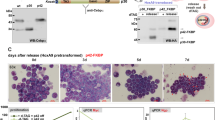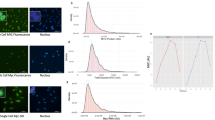Abstract
The c-myc gene product is a nuclear protein1,2 expressed in a wide variety of cell types3. It has been implicated in the control of normal cell growth as well as transformation4–7, but its exact function is unknown. When the human promyelocytic leukaemia cell line HL60 is treated with retinoic acid, the cells differentiate into granulocytes, and there is a reduction in steady state c-myc RNA of more than 10-fold8. Nuclear runoff assays show that this reduction is caused by a corresponding decrease in the transcription of exon 2. However, only a minor decrease in exon 1 transcription is observed upon differentiation. In undifferentiated HL60 cells there is an approximately 3-fold molar excess of exon 1 transcription over exon 2, and this excess increases to about 15-fold in differentiated cells. This observation suggests that a major component of c-myc transcriptional down-regulation in HL60 cells is at the level of elongation rather than at the level of initiation. The position of the elongation block was mapped to the region of the boundary between exon 1 and intron 1. During HL60 differentiation, a DNase I hypersensitive site in the chromatin about 300 bases downstream of the 5′ end of of intron 1 increases in intensity relative to other sites, possibly reflecting events associated with the termination of transcription. Our runoff analysis also revealed transcription of both strands immediately upstream of exon 1 in HL60 cells. The sense strand transcription of this region produces a novel c-myc RNA which initiates several hundred bases upstream of the previously defined promoters and is found in a variety of cell types.
This is a preview of subscription content, access via your institution
Access options
Subscribe to this journal
Receive 51 print issues and online access
$199.00 per year
only $3.90 per issue
Buy this article
- Purchase on Springer Link
- Instant access to full article PDF
Prices may be subject to local taxes which are calculated during checkout
Similar content being viewed by others
References
Alitalo, K. et al. Nature 306, 274–277 (1983).
Hann, S., Abrams, H., Rohrschneider, L. & Eisenman, R. Cell 34, 789–798 (1983).
Gonda, T., Sheiness, D. & Bishop, Molec. Cell. Biol. 2, 617–624 (1982).
Hayward, W., Neel, B. & Astrin, S. Nature 290, 475–480 (1981).
Kelly, K., Cochran, B., Stiles, C. & Leder, P. Cell 35, 603–610 (1983).
Land, H., Parada, L. & Weinberg, R. Nature 304, 596–602 (1983).
Palmieri, S., Kahn, P. & Graf, T. EMBO J. 2, 2385–2389 (1983).
Westin, E., et al. Proc. natn. Acad. Sci. U.S.A. 79, 2490–2494 (1982).
Dony, C., Kessel, M. & Gruss, P. Nature 317, 636–639 (1985).
Greenberg, M. & Ziff, E. Nature 311, 433–438 (1984).
Blanchard, J-M. et al. Nature 317, 443–445 (1985).
Hayday, A. et al. Nature 307, 334–340 (1984).
Hawley, D. & Roeder, R. J. biol. Chem. 260, 8163–8172 (1985).
Lindell, T., Weinberg, F., Morris, P., Roeder, R. & Rutter, W. Science 170, 447–448 (1970).
Groudine, M., Peretz, M. & Weintraub, H. Molec. Cell. Biol. 1, 281–288 (1981).
Schibier, U., Hagenbuchle, O., Wellauer, P. & Pittet, A. Cell 33, 501–508 (1983).
Linial, M., Gunderson, N. & Groudine, M. Science 230, 1126–1132 (1985).
Baralle, F., Shoulders, C. & Proudfoot, N. Cell 21, 621–626 (1980).
Bentley, D. and Groudine, M. Molec. cell. Biol. (in the press).
ar-Rushdi, A. et al. Science 222, 390–393 (1983).
Grosso, L. & Pitot, H. Cancer Res. 45, 847–850 (1985).
Gazin, C. et al.. EMBO J. 3, 383–387 (1984).
Crouse, G., Leys, E., McEwan, R., Frayne, E. & Kellems, R. Molec. cell. Biol. 5, 1847–1858 (1985).
Melton, D. et al. Nucleic Acids Res. 12, 7035–7056 (1984).
Bentley, D. L. Nature 307, 77–80 (1984).
Cleveland, D. et al. Cell 20, 95–105 (1980).
Stalder, J., Groudine, M., Dodgson, J., Engel, D. & Weintraub, H. Cell 19, 973–980 (1980).
Siebenlist, U., Hennighausen, L., Battey, J. & Leder, P. Cell 37, 381–391 (1984).
Dyson, P., Littlewood, T., Forster, Z. & Rabbits, T. EMBO J. 4, 2885–2892 (1985).
Bogenhagen, D. & Brown, D. Cell 24, 261–270 (1981).
Hatfield, G., Sharp, J. & Rosenberg, M. Molec. cell. Biol. 3, 1687–1693 (1983).
Sato, K., Back, K-H. & Agarwal, K. Molec. cell. Biol. 6, 1032–1043 (1986).
Maderious, A. & Chen-Kiang, S. Proc. natl. Acad. Sci. U.S.A. 81, 5931–5935 (1984).
Gingeras, T. et al. J. biol. Chem. 257, 13475–13491 (1982).
Bernard, O., Cory, S., Gerondaikis, S., Webb, E. & Adams, J. EMBO J. 2, 2375–2383 (1983).
Author information
Authors and Affiliations
Rights and permissions
About this article
Cite this article
Bentley, D., Groudine, M. A block to elongation is largely responsible for decreased transcription of c-myc in differentiated HL60 cells. Nature 321, 702–706 (1986). https://doi.org/10.1038/321702a0
Received:
Accepted:
Issue Date:
DOI: https://doi.org/10.1038/321702a0
This article is cited by
-
Transcriptional drug repositioning and cheminformatics approach for differentiation therapy of leukaemia cells
Scientific Reports (2021)
-
Causes and consequences of RNA polymerase II stalling during transcript elongation
Nature Reviews Molecular Cell Biology (2021)
-
Organization and regulation of gene transcription
Nature (2019)
-
The pause-initiation limit restricts transcription activation in human cells
Nature Communications (2019)
-
Structure of paused transcription complex Pol II–DSIF–NELF
Nature (2018)
Comments
By submitting a comment you agree to abide by our Terms and Community Guidelines. If you find something abusive or that does not comply with our terms or guidelines please flag it as inappropriate.



